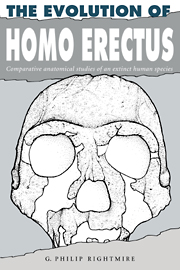Book contents
- Frontmatter
- Contents
- Preface
- 1 Introduction
- 2 Homo erectus in the Far East
- 3 Homo erectus at Olduvai Gorge
- 4 Discoveries from the Turkana basin and other localities in sub-Saharan Africa
- 5 Northwest Africa
- 6 Comparisons of African hominids with Asian Homo erectus
- 7 Homo erectus as a paleospecies
- 8 The transition to more modern forms
- 9 Summary and prospects for further research
- References
- Author index
- Subject index
7 - Homo erectus as a paleospecies
Published online by Cambridge University Press: 14 October 2009
- Frontmatter
- Contents
- Preface
- 1 Introduction
- 2 Homo erectus in the Far East
- 3 Homo erectus at Olduvai Gorge
- 4 Discoveries from the Turkana basin and other localities in sub-Saharan Africa
- 5 Northwest Africa
- 6 Comparisons of African hominids with Asian Homo erectus
- 7 Homo erectus as a paleospecies
- 8 The transition to more modern forms
- 9 Summary and prospects for further research
- References
- Author index
- Subject index
Summary
As described so far, Homo erectus is an extinct species known from several areas of the Old World. Fossils from Java and China display a suite of archaic characters, by which these individuals can easily be distinguished from more modern humans. Many of the same traits can be recognized in the material from Africa. Jaws from Ternifine are very similar to those excavated in the cave at Zhoukoudian. More ancient crania, mandibles (and other body parts) from Olduvai and the Koobi Fora region also resemble the remains from Asia, and it is probable that just one species is sampled in all of these geographic areas.
If it is agreed that Homo erectus ranged widely over a long span of Pleistocene time, an important question may be raised. This concerns the way in which species should be defined by paleontologists, who must focus on the fossil record. Some workers regard paleospecies simply as divisions or segments of larger evolutionary lineages. Species treated in this sense have no clear origin and are assumed to be transformed gradually into descendent groups. Boundaries between such taxa are largely arbitrary. Alternatively, paleospecies may be seen as discrete entities, as sets of populations which are readily separated from other extinct or living groups using morphological criteria. Evidence bearing on this issue of the distinctiveness of Homo erectus is presented below. It is my contention that the fossils document more than just a grade or stage in human evolution.
- Type
- Chapter
- Information
- The Evolution of Homo ErectusComparative Anatomical Studies of an Extinct Human Species, pp. 180 - 203Publisher: Cambridge University PressPrint publication year: 1990

